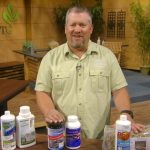Pond Algae
There are several types of algae, but here are a couple that are most common in our water features.
Hair algae
The number one algae is hair algae. It’s the long, stringy fibrous algae. It’s also called Angel hair algae.
Chemical control
You can control it chemically with actual algaecides that contain copper sulfate.
Products include:
- Microbe-Lift Algaway 5.4
- PondCare AlgaeFix
You usually treat with them every three days, and after the third treatment, you will actually see the algae whiten and die. Note: Please read all instructions and follow them carefully.
Oxidizers
- Rescue Water Treatment Oxygen powdered cleaner
- Green Clean granular algaecide
These are powders that you shake onto the hair algae. Immediately, the algae starts to whiten and die. What it does is actually makes contact with organic matter that’s in the pond, and you will actually see it kind of bubble up. It’ll stir your pond up a little bit, but in a day, it clears up quite well.
Preventives
I prefer to combat algae with prevention, like barley straw. It creates peroxides as it decomposes. As it breaks down and the peroxides are formed, it helps prevent the growth of algae. One small bale would last about 4-5 months.
Pond Perfect multi-purpose biological pond treatment is a very new product. I’ve had great success with it. It actually gets to the source of what’s causing your algae growth. It has natural bacteria in it that help eat the organic matter that’s in your pond. As the organic matter starts to break down and is removed, you’re also removing the source or the food supply for the algae.
Green water, pea soup algae
This is another common algae. It can be maintained in several ways, usually with biological filtration, using plenty of plants. We like to recommend about 60% coverage of plants in your pond. If it’s little more severe and your pond is just for koi, not plants, you can also use ultraviolet light.
Article Type: How To
categories:
tags:
related:








 Steve Kainer
Steve Kainer